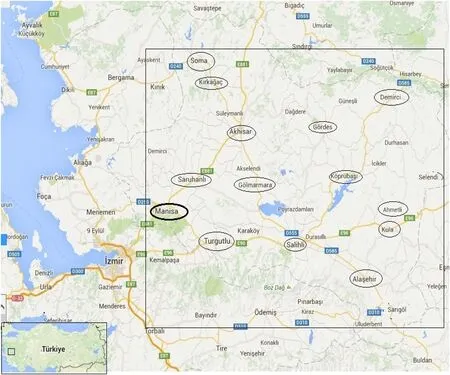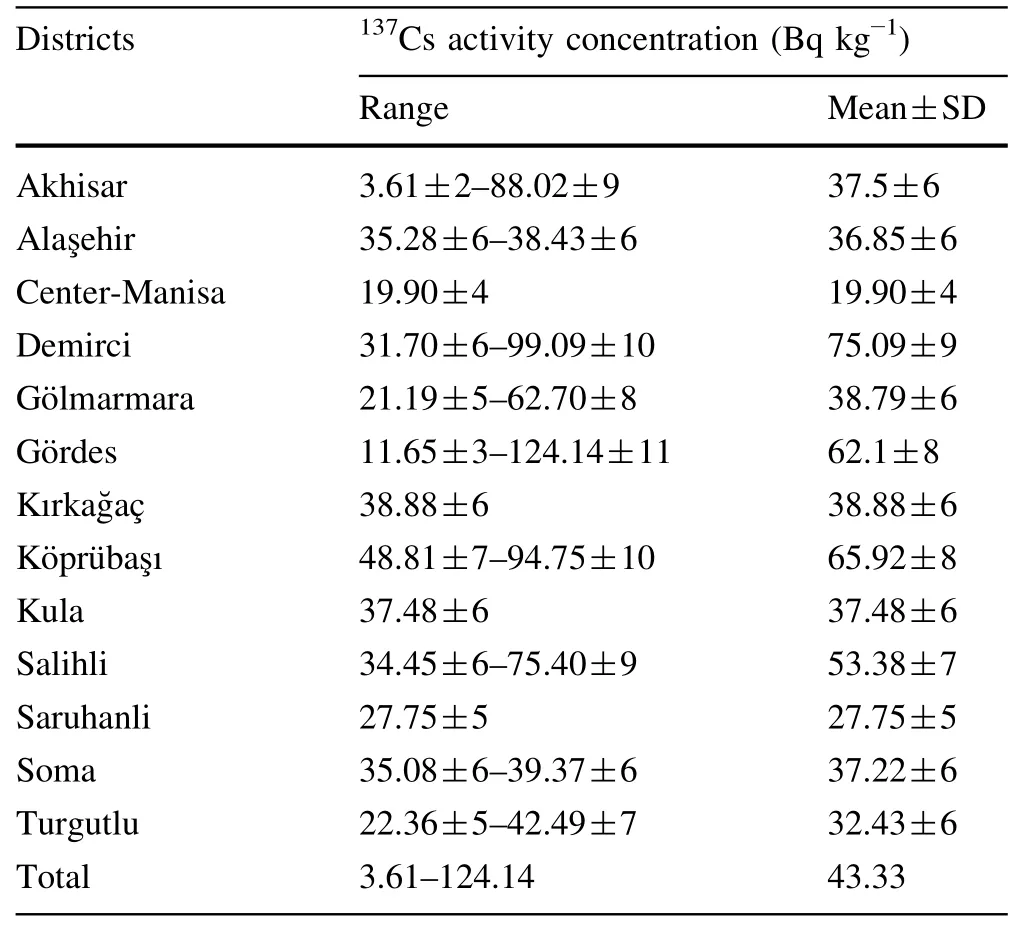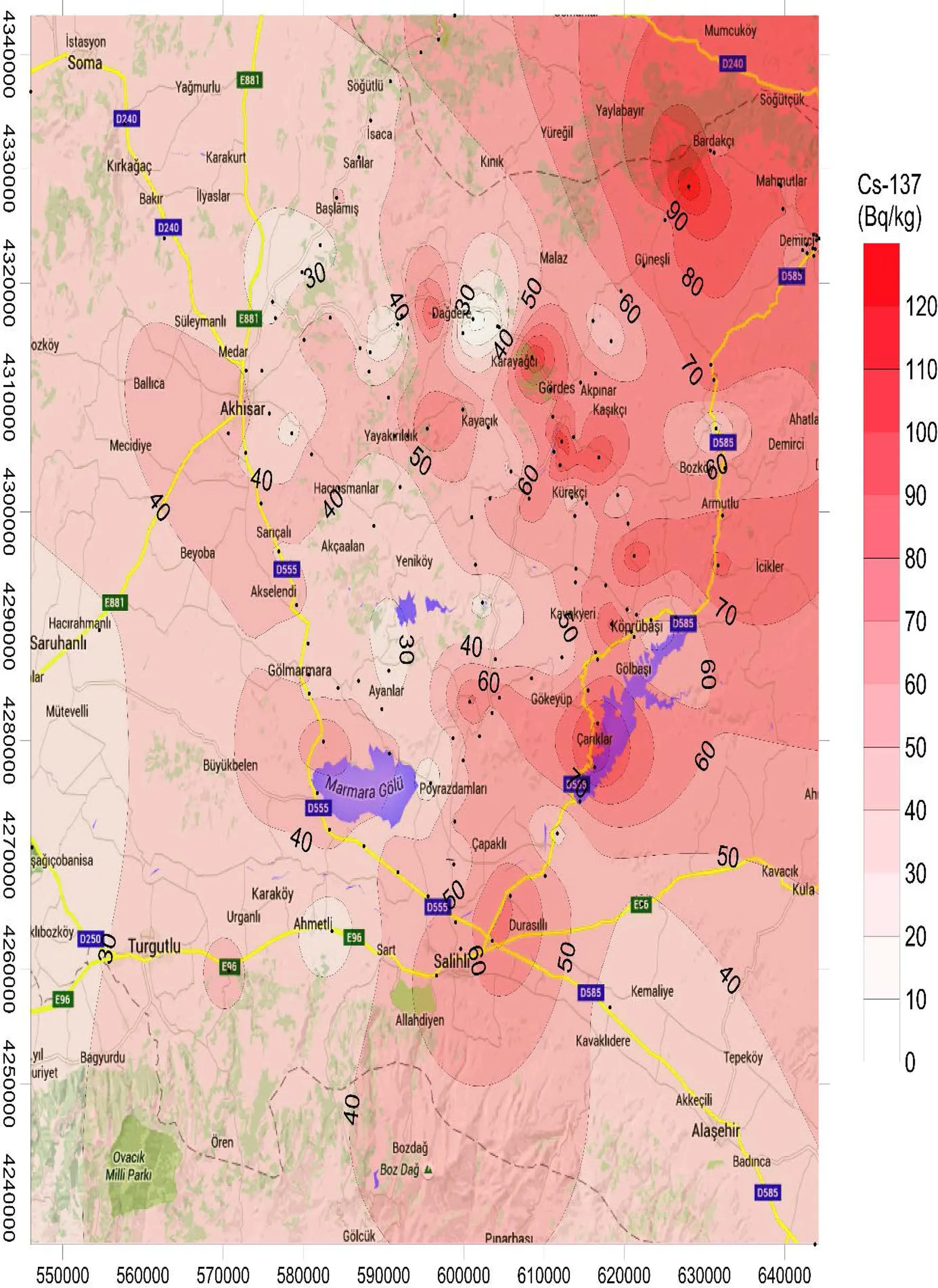Annual effective dose values from137Cs activity concentrations in soils of Manisa,Turkey
2018-06-27SerminamKaynar
Sermin Çam Kaynar
1 Introduction
Natural and artificial radioactive sources are the cause of radioactivity in the environment[1].According to the UNSCEAR report(2000),estimates of the total radiation dose within 1 year indicated that about 86%of it is from natural radioactivity,whereas 14%is from anthropogenic sources[2,3].Artificial radionuclides are generated in nuclearreactoraccidents,military use,and nuclear industrial activities.137Cs is an artificial radionuclide.It is produced by activation processes and nuclear fission[1].The half-life of this artificial radionuclide is approximately 30.17 years.It emits gamma rays with an energy of 661.6 keV.Gamma radiation from137Cs contributes to the external exposure[4,5].
Soil contamination by137Cs arises from global fallout from the atmosphere caused by nuclear weapon tests,nuclear explosions,and nuclear accidents.137Cs is a fission product that enters the environment[6].It is the most important source of radiation exposure after nuclear accidents such as Chernobyl[7].About 3.8×1016Bq of137Cs from the Chernobyl accident was released into the environment[4,8].Measurements of137Cs in soils provide clues to the internal and external radiation exposure of people living in the investigated areas.The movement of137Cs into the food chain depends powerfully on the soil composition and on the migration action of137Cs in the soil.Thus,the measurement of137Cs in soils is important for radioecology and radiological protection[7].
After the Chernobyl accident,an important reactor accidents and experimental studies were performed to determine the levels of137Cs contamination in soils taken from different areas of the world[4,5,9–13].
This study aims to determine the137Cs deposition levels in Manisa,Turkey,and to provide regional background levels for the study area.The data in this study will be useful as reference data for future prediction of human exposure.
2 Materials and methods
2.1 Study area
The city of Manisa is located in the Aegean Region of Turkey(Fig.1).Manisa Province is surrounded by Us¸ak and Kütahya to the east,Balıkesir to the north,Aydın to the south,Denizli to the southeast,and Izmir to the west and southwest.The province has a population of approximately 1,380,366.Its surface area is 13,810 km2.Geographically,the city of Manisa lies between 27°08′and 29°05′E longitudes and 38°04′and 39°58′N latitudes.There are mountains and rugged areas to the north,east,and south of the city of Manisa.There are creeks and streams to the west of the city.The elevation of the city of Manisa increases from west to east(50–850 m).The height of the city center is 71 m.The highest point in the center is Spil Mountain(1513 m).The highest point of the city of Manisa is in Salihli Bozdag˘lar Kumtepe(2070 m).The highest district in the province is Demirci(850 m).
Manisa Province is made up of 16 districts:Ahmetli,Akhisar,Alas¸ehir,Center-Manisa,Demirci,Gölmarmara,Gördes,Kırkagǎc¸,Köprübas¸ı,Kula,Salihli,Sarigol,Saruhanli,Selendi,Soma,and Turgutlu.
2.2 137Cs activity measurements
One hundred fifty sampling locations in Manisa Province were chosen for soil sampling.The number of sampling locations by districts varies as follows:Akhisar,36;Alas¸ehir,2;Center-Manisa,1;Demirci,22;Gölmarmara,15;Gördes,29;Kırkagǎc¸,1;Köprübas¸ı,19;Kula,1;Salihli,19;Saruhanlı,1;Soma,2;and Turgutlu,2.
The sampling locations are located close to highways.Soil samples of approximately 2 kg were taken from 15 to 20 cm of soil in uncultivated areas,and stones,pebbles,vegetation,and roots were removed.They were placed in clear plastic bags,labeled according to the location of the sampling point and taken to the laboratory.The coordinates of each sampling point were measured with a GPS navigator(Garmin).

Fig.1(Color online)Sampling locations in Manisa Province
All the soil samples collected in the study area were dried at 50°C for 24 h to remove moisture.These samples were sieved.1 kg of soil samples were weighed and placed in Marinelli beakers.
Each of the soil samples was measured using a γ-spectrometer equipped with a 3-in.×3-in.NaI(Tl)detector.The NaI(Tl)detector was coupled to an Ortec multichannel analyzer.For system calibration,the radioactive137Cs standard source taken from Cekmece Nuclear Research and Training Center of Turkish Atomic Energy was used in this study.The 662 keV gamma ray of137Cs was used for measurements.The spectrum of every soil sample was counted for 7200 s(2 h).The background measurement was conducted under the same conditions as the sample measurement.The net integral counts were determined.Then,the137Cs activity concentration was calculated in units of becquerels per kilogram.
3 Results and discussion
The137Cs activity concentrations measured in the soils collected from the Manisa districts are given in Table 1.
The activity concentrations in the soils ranged from 3.61 to 124.14 Bq kg−1,with a mean value of 43.33 Bq kg−1.The lowest activity of137Cs(3.61 Bq kg−1)was detected in the Akhisar district, and the highest activity(124.14 Bq kg−1)was detected in the Gördes district.Among the average137Cs activity values for the districts,the lowest was measured as 19.90 Bq kg−1in Center-Manisa,and the highest was measured as 65.92 Bq kg−1in the Köprübas¸ı district.

Table 1 Range and mean137Cs activity in soils from each district in Manisa Province
A regional distribution map of the137Cs activity concentrations in the samples is given in Fig.2.
Figure 2 shows that the137Cs activities(>60 Bq kg−1)in the Demirci,Gördes,and Köprübas¸ı districts were higher than those from the Akhisar,Gölmarmara,Saruhanlı,Kula,Soma,and Turgutlu districts(<50 Bq kg−1).The Demirci,Gördes,and Köprübas¸ı districts are at higher elevations than the other districts.137Cs,an artificial radionuclide,is dispersed into the environment via atomic explosions in nuclear weapons tests,surface and underground nuclear explosions,and reactor accidents such as the well-known Chernobyl accident,and presents itself as fallout in the atmosphere[6,14].
The presence of137Cs in the study region is more likely to be a consequence of the Chernobyl accident,in 1986.Due to the rainfall after the Chernobyl accident,it can be thought that the districts in this study were exposed to radioactive fallout.The major factors affecting the distribution of137Cs worldwide are the latitude and precipitation rate[1].An atmospheric deposition of137Cs has appeared as a characteristic background component in topsoil samples from the northern hemisphere.The deposition of the137Cs originating in a nuclear accident is more localized according to the meteorological conditions[1].
The frequency distribution of the137Cs activity is given in Fig.3.
It shows a normal distribution.It can be seen that 98%of the samples are in the normal Gaussian distribution,and 2%are outside of this distribution.The137Cs activity of 98%of the samples is lower than 100 Bq kg−1.The three soil samples taken from Gördes district are the only ones showing activities higher than 100 Bq kg−1.
The absorbed dose rate(D)in outdoor air(nGy h−1)at 1 m above the ground surface for137Cs was calculated as follows:

where A is the specific activity of137Cs,and the dose conversion factor for converting the137Cs activity into the dose rate is 0.03(nGy h−1per Bq kg−1)[2,15].
The annual effective dose rate(E)(mSv y−1)was calculated as follows:

where Q is a conversion coefficient(0.7 Sv Gy−1)for converting the absorbed dose in air to the effective dose;OF is the occupancy factor for outdoors(0.2)and for indoors(0.8)and T is the number of hours in a year(8760 h)[2,16].

Fig.2(Color online)Regional distribution map of137Cs activity in soils(contour interval:10 Bq kg−1)
The absorbed dose rate and annual effective doses(outdoor,indoor,and total)were calculated from the137Cs activity concentrations measured in the soil samples(Table 2).The calculated results showed that the annual effective dose(total)varied from 3.66(in the Center-Manisa district)to 13.81 µSv y−1(in the Demirci district),with a mean value of 7.97 µSv y−1.These results are below the worldwide annual dose value of 70 µSv y−1reported by UNSCEAR.In addition,the highest value(13.81 µSv y−1)is approximately one- fifth of 70 µSv y−1.

Fig.3 Frequency distribution graphic of137Cs activity in soils
The measured activity and calculated annual effective dose from137Cs in this study were compared with those in reported studies of other countries worldwide and other provinces of Turkey(Table 3).The maximum annual effective dose from137Cs in this study is higher than the results calculated for the Sultanate of Oman,Pakistan,and Ordu(Turkey),but lower than those for the Eastern Black Sea(Turkey).
When the results of this study are compared to those of other studies,they are found to be higher than those reported for Saudi Arabia(0.8–3.1 Bq kg−1),Egypt(0–5.70 Bq kg−1),India(1.0–2.8 Bq kg−1),Egypt(1.2–5.1 Bq kg−1),Republika Srpska(2.1–68 Bq kg−1),Hungary(0.5–61.1 Bq kg−1),Turkey(2.81–20.75 Bq kg−1),Adana(Turkey) (0.1–28 Bq kg−1),Kocaeli(Turkey) (2–25 Bq kg−1),and Kars(Turkey)(18.1 Bq kg−1),but lower than those for Korea,(5.9–285.4 Bq kg−1),the Eastern Black Sea(Turkey)(27–775 Bq kg−1),Ordu(Turkey)(67.4–275.3 Bq kg−1), and Trabzon (Turkey) (6–199 Bq kg−1).
4 Summary and conclusion
In this work,the137Cs activity concentrations in soils from Manisa Province,Turkey,were determined.The average annual effective doses(outdoor,indoor,and total)for soil samples were calculated using the137Cs activity concentrations.
The following results were obtained.
● The137Cs activity levels in soils were found to range from 3.61 Bq kg−1(in the Akhisar district)to 124.14 Bq kg−1(in the Gördes district),with a mean value of 43.33 Bq kg−1for all 13 districts in Manisa Province.

Table 2 Dose rate and annual effective doses of137Cs in each district in Manisa Province

Table 3 Comparison of the137Cs activity and annual effective dose from137Cs in soil samples reported various studies
● The average annual effective doses(outdoor,indoor,and total)of the soil samples were found to be 1.59,6.38,and 7.97 µSv y−1,respectively.
● These calculated values were below the worldwide annual dose of 70 µSv y−1reported by the UNSCEAR report(2000)and the recommended annual dose rate limit of 1 mSv y−1recommended by ICRP 1990[2,22].
It is thought that the radionuclide137Cs originated in the Chernobyl accident.The results obtained in this work showed that the137Cs radiation level in Manisa will not pose any significant health threat.In addition,the results will be displayed in important data for the predictions of radioactive pollution and can be used as a reference data for any radiological accident worldwide.
AcknowledgementsI am grateful to Umit Hüseyin Kaynar for his support of this work.
1.I.H.Saleh,Radioactivity of238U232Th40K and137Cs and assessment of depleted uranium in soil of the Musandam Peninsula Sultanate of Oman.Turk.J.Eng.Environ.Sci.TUBITAK 36,236–248(2012).https://doi.org/10.3906/muh-1110-1
2.UNSCEAR(United Nations Scientific Committee on the Effects of Atomic Radiation),Sources and effects of ionizing radiation(United Nations,New York,2000)
3.G.B.Cengiz,S.Res¸itog˘lu,Determination of natural radioactivity levels in Kars City center,Turkey.J.Nucl.Sci.1(2),32–38(2014).https://doi.org/10.1501/nuclear_0000000005
4.S.N.A.Tahir,J.Jamil,J.H.Zaidi et al.,Activity concentration of137Cs in soil samples from Punjab province(Pakistan)and estimation of gamma-ray dose rate for external exposure.Radiat.Prot.Dosim.118(3),345–351(2006).https://doi.org/10.1093/rpd/nci351
5.A.Nada,T.M.Abd-El Maksoud,M.Abu-Zeid Hosnia et al.,Distribution of radionuclides in soil samples from a petrified wood forest in El-Qattamia Cairo Egypt.Appl.Radiat.Isot.67,643–649(2009).https://doi.org/10.1016/j.apradiso.2008.11.016
6.M.A.A.Aslani,S¸.Aytas,S.Akyil et al.,Activity concentration of caesium-137 in agricultural soils.J.Environ.Radioact.65,131–145(2003).https://doi.org/10.1016/S0265-931X(02)00092-9
7.A.Daraoui,R.Michel,M.Gorny et al.,Iodine-129,iodine-127 and caesium-137 in the environment,soils from Germany and Chile.J.Environ.Radioact.112,8–22(2012).https://doi.org/10.1016/j.jenvrad.2012.02.011
8.A.S.Alaamer,Characterization of137Cs in Riyadh Saudi Arabia soil samples.World J.Nucl.Sci.Technol.2,161–164(2012).https://doi.org/10.4236/wjnst.2012.24024
9.V.Kannan,M.P.Rajan,M.A.R.Iyengar et al.,Distribution of natural and anthropogenic radionuclides in soil and beach sand samples of Kalpakkam(India)using hyper pure germanium(HPGe)gamma ray spectrometry.Appl.Radiat.Isot.57,109–119(2002).https://doi.org/10.1016/S0969-8043(01)00262-7
10.H.I.El-Reefy,T.Sharshar,R.Zaghloul et al.,Distribution of gamma-ray emitting radionuclides in the environment of Burullus Lake,I soils and vegetations.J.Environ.Radioact.87,148–169(2006).https://doi.org/10.1016/j.jenvrad.2005.11.006
11.M.Jankovic,D.Todorovic,M.Savanovic,Radioactivity measurements in soil samples collected in the Republic of Srpska.Radiat.Meas.43,1448–1452(2008).https://doi.org/10.1016/j.radmeas.2008.03.004
12.A.Sakaguchi,A.Kadokura,P.Steier et al.,Isotopic determination of U,Pu and Cs in environmental waters following the Fukushima Daiichi Nuclear Power Plant accident.Geochem.J.46,355–360(2012).https://doi.org/10.2343/geochemj.2.0216
13.K.Z.Szabo,B.Udvardi,A.Horvath et al.,Cesium-137 concentration of soils in Pest County Hungary.J.Environ.Radioact.110,38–45(2012).https://doi.org/10.1016/j.jenvrad.2012.01.023
14.N.Celik,N.Damla,U.Cevik,Gamma ray concentrations in soil and building materials in Ordu,Turkey.Radiat.Eff.Defects Solids 165, 1–10 (2010). https://doi.org/10.1080/10420150903173270
15.M.Ra fique,Cesium-137 activity concentrations in soil and brick samples of Mirpur Azad Kashmir Pakistan.Int.J.Radiat.Res.12(1),39–46(2014)
16.A.Al-Sharkawy,MTh Hiekal,M.I.Sherif et al.,Environmental assessment of gamma-radiation levels in stream sediments around Sharm El-Sheikh.South Sinai,Egypt.J.Environ.Radioact.112,76–82(2012).https://doi.org/10.1016/j.jenvrad.2012.05.020
17.M.H.Lee,C.W.Lee,Association of fallout-derived137Cs,90Sr and239,240Pu with natural organic substances in soils.J.Environ.Radioact.47,253–262(2000).https://doi.org/10.1016/S0265-931X(99)00033-8
18.B.Karakelle,N.Öztürk,A.Köse et al.,Natural radioactivity in soil samples of Kocaeli basin Turkey.J.Radioanal.Nucl.Chem.254,649–651(2002).https://doi.org/10.1023/A:1021635415222
19.M.Degerlier,G.Karahan,G.Ozger,Radioactivity concentrations and dose assessment for soil samples around Adana,Turkey.J.Environ.Radioact.99,1018–1025(2008).https://doi.org/10.1016/j.jenvrad.2007.12.015
20.N.Celik,U.Cevik,A.Celik et al.,Natural and artificial radioactivity measurements in Eastern Black Sea region of Turkey.J.Hazard.Mater.162,146–153(2009).https://doi.org/10.1016/j.jhazmat.2008.05.017
21.A.Kurnaz,B.Kücükömerog˘lu,N.Damla et al.,Radiological maps for Trabzon,Turkey.J.Environ.Radioact.102,393–399(2011).https://doi.org/10.1016/j.jenvrad.2011.02.009
22.ICRP,(International Commission on Radiological Protection),Recommendations of the International Commission on Radiological Protection(Pergamon Press,Oxford,1990)
杂志排行
Nuclear Science and Techniques的其它文章
- Gamma irradiation-induced effects on the properties of TiO2 on fluorine-doped tin oxide prepared by atomic layer deposition
- Preliminary analysis of tritium fuel cycle in Z-pinch-driven fusion– fission hybrid reactor
- Investigation of high-temperature-resistant rhenium–boron neutron shields by experimental studies and Monte Carlo simulations
- Monte Carlo simulation of incident electrons passing through thin metal layer
- Preparation and characterization of Bi2O3/XNBR flexible films for attenuating gamma rays
- Investigation of SPECT/CT cardiac imaging using Geant4
